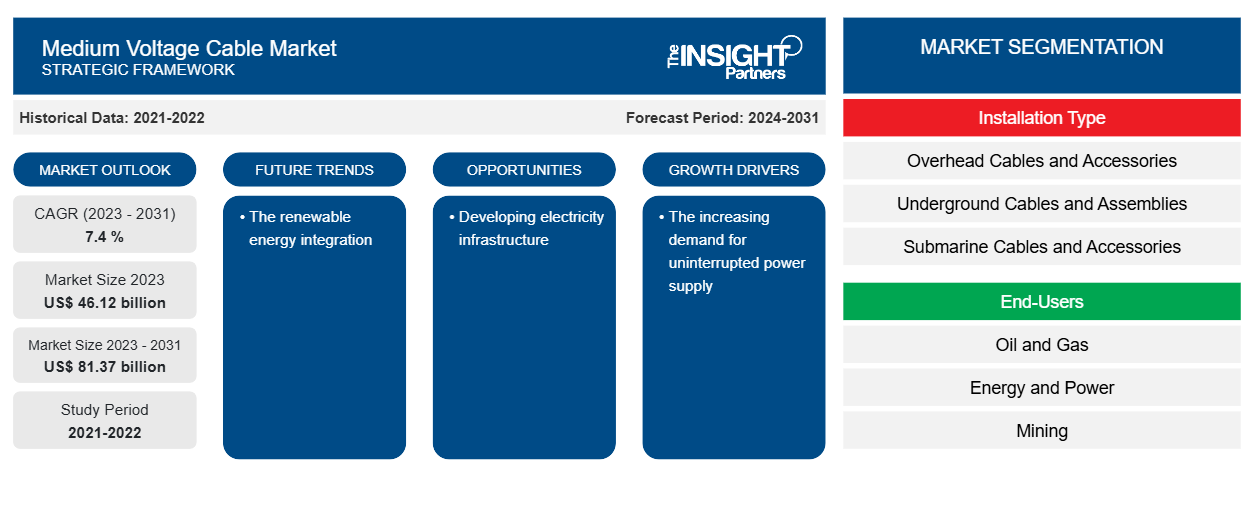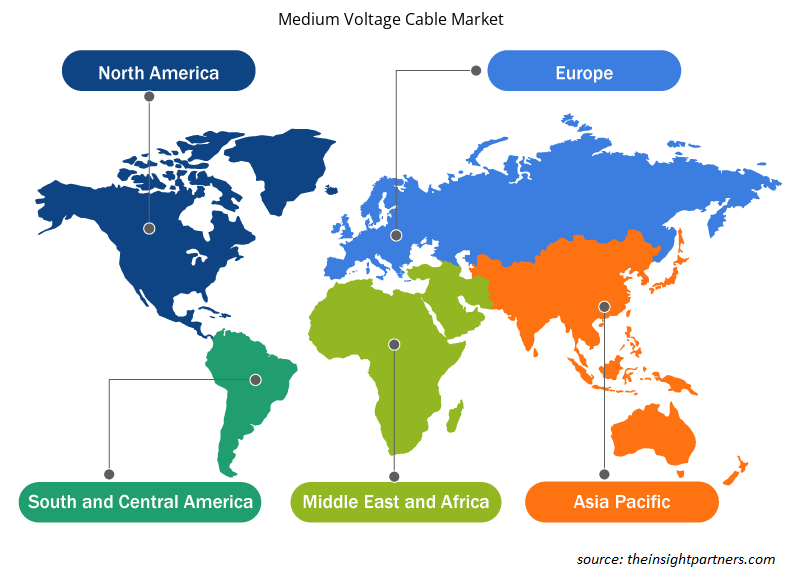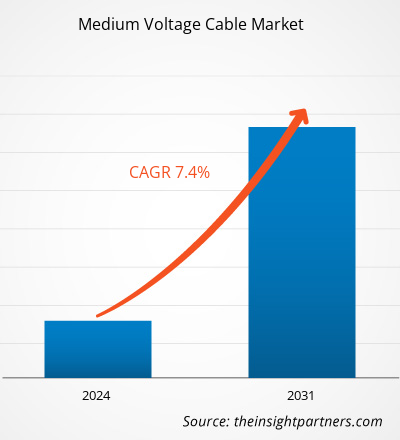Se espera que el tamaño del mercado de cables de media tensión alcance los 41.280 millones de dólares estadounidenses para 2031, frente a los 26.240 millones de dólares estadounidenses de 2024. Se prevé que registre una tasa de crecimiento anual compuesta (TCAC) del 6,9 % entre 2025 y 2031. Es probable que los crecientes avances en la tecnología de cables impulsen nuevas tendencias en el mercado en los próximos años.
Análisis del mercado de cables de media tensión
La creciente demanda energética, el desarrollo de infraestructura y la transición a fuentes de energía renovables impulsan la demanda global de cables de media tensión. Asimismo, el creciente énfasis en la modernización de las redes eléctricas para mejorar la eficiencia y la fiabilidad está acelerando el crecimiento del mercado de cables de media tensión . Asimismo, la creciente adopción de la tecnología de redes inteligentes y vehículos eléctricos requiere una infraestructura de media tensión fiable para facilitar la distribución de energía. Asimismo, los avances tecnológicos en los procesos y materiales de fabricación de cables, como el aislamiento de polietileno reticulado ( XLPE ), mejoran el rendimiento y la longevidad de los cables de media tensión, haciéndolos más atractivos para las empresas de servicios públicos y los usuarios industriales, lo que impulsa aún más el crecimiento del mercado.
Descripción general del mercado de cables de media tensión
Los cables eléctricos de media tensión se utilizan en edificios industriales, proyectos de energía renovable y redes de distribución eléctrica. Ofrecen tiempos de transmisión más largos, menores pérdidas de energía y mayor fiabilidad. Los cables de media tensión han sido desde hace tiempo parte integral de los sistemas de distribución eléctrica modernos. Garantizan un suministro eléctrico eficaz y fiable que satisface la demanda diaria, transportando la energía desde las subestaciones hasta diversos puntos finales, como hogares, empresas y plantas industriales. Este aumento de la demanda se debe a que numerosas industrias están utilizando cables de media tensión con mayor frecuencia como resultado de la urbanización, la industrialización, el crecimiento de las energías renovables y la electrificación del transporte.
Recibirá personalización de cualquier informe, sin cargo, incluidas partes de este informe o análisis a nivel de país, paquete de datos de Excel, así como también grandes ofertas y descuentos para empresas emergentes y universidades.
Mercado de cables de media tensión: Perspectivas estratégicas

- Obtenga las principales tendencias clave del mercado de este informe.Esta muestra GRATUITA incluirá análisis de datos, desde tendencias del mercado hasta estimaciones y pronósticos.
Impulsores y oportunidades del mercado de cables de media tensión
Crecimiento del sector de las energías renovables
Para finales de 2023, la energía renovable limpia representaba el 43% de la capacidad instalada mundial, lo que representa el mayor aumento en la capacidad verde, debido principalmente al fuerte aumento del consumo de energía solar y eólica. Además, con el creciente número de proyectos de energía renovable en todo el mundo, existe una creciente necesidad de cables robustos de media tensión para conectar las instalaciones de generación de energía a la red y distribuir electricidad a los consumidores. Asimismo, a medida que los países se esfuerzan por cumplir los objetivos de energía renovable y reducir las emisiones de carbono, se prevé que la demanda de soluciones eficaces de media tensión aumente en los próximos años. Además, con las modificaciones en la infraestructura de la red subyacente ya en marcha, la demanda de cables de media tensión de 11 kV está aumentando a nivel internacional.
Innovación en la tecnología de decodificadores (STB)STB) Technology
La creciente adopción de vehículos eléctricos ( VE ) y la consiguiente expansión de la infraestructura de carga crean una oportunidad sustancial para el mercado de cables de media tensión. A medida que más personas y empresas se cambian a vehículos eléctricos, la necesidad de un suministro de energía fiable a las estaciones de carga de VE seguirá creciendo. Los cables de media tensión son fundamentales para conectar la infraestructura de carga a la red eléctrica, garantizar una transferencia de energía eficiente y absorber la creciente carga de los sistemas eléctricos existentes. Gobiernos y empresas están realizando importantes inversiones en redes de carga de VE , lo que se espera que genere una oportunidad para el crecimiento del mercado de cables de media tensión.
Análisis de segmentación del informe de mercado de cables de media tensión
Los segmentos clave que contribuyeron a la derivación del análisis del mercado de cables de media tensión son la instalación, el voltaje y el usuario final.
- Según la instalación, el mercado se divide en aéreo, subterráneo y submarino. El segmento aéreo se subdivide en conductor de aluminio reforzado con acero (ACSR), conductor de aleación de aluminio (AAAC), conductor de aleación de aluminio reforzado con acero (AACSR), entre otros. El segmento subterráneo se subdivide en polietileno reticulado (XLPE), cloruro de polivinilo (PVC), aislamiento de papel recubierto de plomo (PILC), entre otros. El segmento aéreo dominó el mercado en 2024.
- Por voltaje, el mercado se segmenta en 6 a 13 kV, 23 kV, 34 kV, 45 kV, 69 kV y 1 a 5 kV. El segmento de 6 a 13 kV dominó el mercado en 2024.
- En términos de usuario final, el mercado se clasifica en industrial, de infraestructura y de energías renovables. El segmento industrial dominó el mercado en 2024.
Análisis de la cuota de mercado de cables de media tensión por geografía
El mercado de cables de media tensión se segmenta en cinco regiones principales: América del Norte, Europa, Asia Pacífico, Oriente Medio y África (MEA) y América del Sur. Asia Pacífico dominó el mercado en 2024.
La región Asia Pacífico experimenta una creciente demanda de cables de media tensión debido a la rápida urbanización, industrialización y creciente demanda energética. Países como China e India impulsan esta expansión, invirtiendo ampliamente en el desarrollo de infraestructura y proyectos de energía renovable para impulsar sus economías en auge. El mayor énfasis en proyectos de ciudades inteligentes y la modernización de la red eléctrica incrementa la demanda de soluciones fiables de media tensión. Además, el creciente uso de vehículos eléctricos (VE) en países como Japón, Corea del Sur y Australia presenta un gran potencial para los cables de media tensión como soporte de la infraestructura de carga de VE. Los programas gubernamentales que apoyan la energía limpia y la sostenibilidad también impulsan la industria, ya que fomentan la inversión en fuentes de energía renovables como la solar y la eólica, que requieren líneas de transmisión de media tensión eficientes.
Perspectivas regionales del mercado de cables de media tensión
Los analistas de Insight Partners han explicado detalladamente las tendencias y los factores regionales que influyen en el mercado de cables de media tensión durante el período de pronóstico. Esta sección también analiza los segmentos y la geografía del mercado de cables de media tensión en Norteamérica, Europa, Asia Pacífico, Oriente Medio y África, y Sudamérica y Centroamérica.

- Obtenga los datos regionales específicos para el mercado de cables de media tensión
Alcance del informe de mercado de cables de media tensión
| Atributo del informe | Detalles |
|---|---|
| Tamaño del mercado en 2024 | US$ 26.24 mil millones |
| Tamaño del mercado en 2031 | US$ 41.28 mil millones |
| CAGR global (2025-2031) | 6,9% |
| Datos históricos | 2021-2023 |
| Período de pronóstico | 2025-2031 |
| Segmentos cubiertos | Por instalación
|
| Regiones y países cubiertos | América del norte
|
| Líderes del mercado y perfiles de empresas clave |
|
Densidad de actores del mercado de cables de media tensión: comprensión de su impacto en la dinámica empresarial
El mercado de cables de media tensión está creciendo rápidamente, impulsado por la creciente demanda de los usuarios finales debido a factores como la evolución de las preferencias de los consumidores, los avances tecnológicos y una mayor conciencia de las ventajas del producto. A medida que aumenta la demanda, las empresas amplían su oferta, innovan para satisfacer las necesidades de los consumidores y aprovechan las tendencias emergentes, lo que impulsa aún más el crecimiento del mercado.
La densidad de actores del mercado se refiere a la distribución de empresas o compañías que operan en un mercado o sector en particular. Indica cuántos competidores (actores del mercado) hay en un mercado determinado en relación con su tamaño o valor total.
Las principales empresas que operan en el mercado de cables de media tensión son:
- ABB Ltd
- Prysmian SpA
- Nexans SA
- TE Connectivity Ltd
- Compañía Southwire LLC
- Compañía de cables y alambres de Houston
Descargo de responsabilidad : Las empresas enumeradas anteriormente no están clasificadas en ningún orden particular.

- Obtenga una descripción general de los principales actores clave del mercado de cables de media tensión
Noticias y desarrollos recientes del mercado de cables de media tensión
El mercado de cables de media tensión se evalúa mediante la recopilación de datos cualitativos y cuantitativos tras la investigación primaria y secundaria, que incluye importantes publicaciones corporativas, datos de asociaciones y bases de datos. A continuación, se enumeran algunos de los avances en el mercado de cables de media tensión:
- Amokabel anunció el lanzamiento de su nuevo cable de media tensión, desarrollado con un fuerte enfoque en la sostenibilidad, la calidad y la flexibilidad, y fabricado con energía 100 % renovable. Este nuevo cable combina un alto rendimiento técnico con un compromiso con la responsabilidad ambiental.
(Fuente: Amokabel, comunicado de prensa, mayo de 2025)
- NKT está invirtiendo en capacidad de producción adicional y capacidades en sus fábricas de media tensión en Dinamarca, Suecia y la República Checa para satisfacer la creciente demanda de los clientes de cables de alimentación de media tensión necesarios para las actualizaciones de la red y los proyectos de energía renovable en toda Europa.
(Fuente: NKT, comunicado de prensa, abril de 2024)
Informe de mercado sobre cables de media tensión: cobertura y resultados
El informe "Tamaño y pronóstico del mercado de cables de media tensión (2021-2031)" ofrece un análisis detallado del mercado que abarca las siguientes áreas:
- Tamaño del mercado de cables de media tensión y pronóstico a nivel regional y nacional para todos los segmentos clave del mercado cubiertos bajo el alcance
- Tendencias del mercado de cables de media tensión, así como dinámicas del mercado, como impulsores, restricciones y oportunidades clave.
- Análisis PEST y FODA detallado
- Análisis del mercado de cables de media tensión que abarca las tendencias clave del mercado, el marco regional, los principales actores, las regulaciones y los desarrollos recientes del mercado.
- Análisis del panorama industrial y de la competencia que abarca la concentración del mercado, el análisis de mapas de calor, los actores destacados y los desarrollos recientes en el mercado de cables de media tensión.
- Perfiles detallados de empresas
- Análisis histórico (2 años), año base, pronóstico (7 años) con CAGR
- Análisis PEST y FODA
- Tamaño del mercado, valor/volumen: global, regional y nacional
- Industria y panorama competitivo
- Conjunto de datos de Excel
Informes recientes
Informes relacionados
Testimonios
Razón para comprar
- Toma de decisiones informada
- Comprensión de la dinámica del mercado
- Análisis competitivo
- Información sobre clientes
- Pronósticos del mercado
- Mitigación de riesgos
- Planificación estratégica
- Justificación de la inversión
- Identificación de mercados emergentes
- Mejora de las estrategias de marketing
- Impulso de la eficiencia operativa
- Alineación con las tendencias regulatorias






















 Obtenga una muestra gratuita para - Mercado de cables de media tensión
Obtenga una muestra gratuita para - Mercado de cables de media tensión